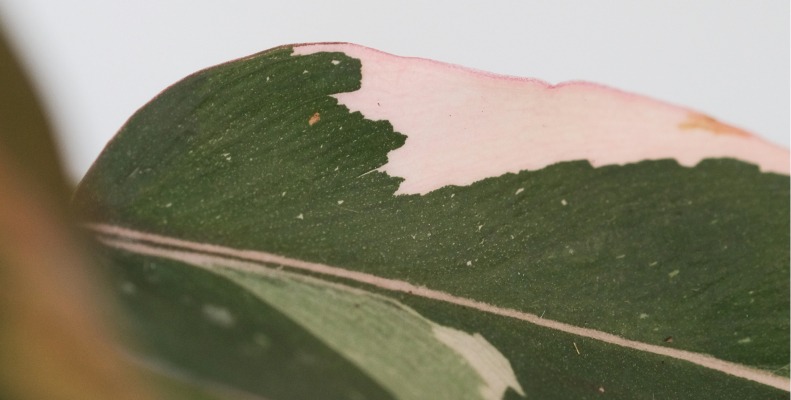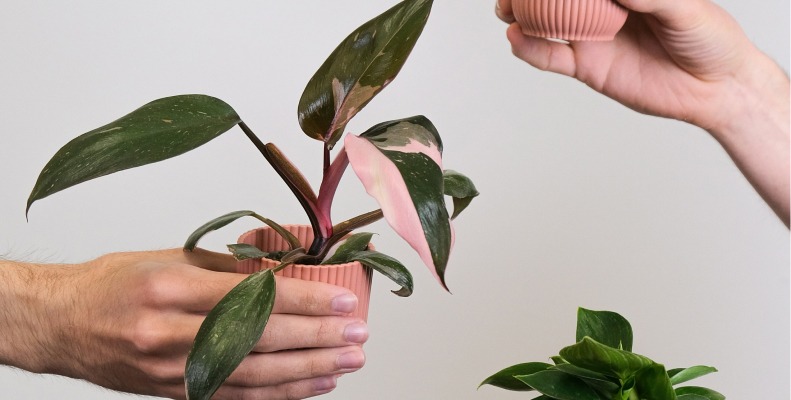The pink princess philodendron, known as Philodendron erubescens ‘pink princess,’ is a top choice for many. It has bright, deep green leaves shaped like hearts. These leaves have stunning pink spots. Knowing the right care for this plant is key for its beauty and health.
Key Takeaways:
- Pink princess philodendron is a tropical plant with green leaves and vibrant pink variegation.
- Proper care is essential to maintain the plant’s variegation and promote healthy growth.
- Pink princess philodendron requires bright, indirect light and well-draining soil.
- Water the plant when the top half of the soil is dry, and avoid overwatering to prevent root rot.
- Fertilize the plant during the growing season and repot it every 1 to 2 years.
Pink Princess Plant Care: Light and Soil Requirements
Light is very important for the pink princess philodendron. It loves bright, indirect light, just like in the tropical forests. Place it near a window, but not in direct sunlight. If your home is not sunny, use grow lights to help.
This plant also needs the right kind of soil. Use soil that lets water drain well. It should include one part potting soil, one part perlite, and one part orchid bark. This makes the soil good for the plant and helps its roots stay healthy.
| Light Requirements | Soil Requirements |
|---|---|
| Bright, indirect light | Well-draining soil rich in organic matter |
| Tolerates a few hours of direct light | One part standard potting soil |
| Supplement with grow lights if necessary | One part perlite |
| One part orchid bark |
Pink Princess Plant Care: Watering and Humidity
Keeping the pink princess philodendron correctly watered is key. To keep it healthy, let the top soil dry between waterings. Water the plant well to make sure the roots get enough moisture. In spring and summer, you can water it once a week. However, in the cooler months, water only every 1 to 2 weeks.
Be careful not to overwater. Overwatering may cause the roots to rot. One way to check is to put your finger in the soil. If the soil feels damp, hold off on watering. Water the plant when the soil is dry.
The pink princess philodendron loves warm, humid places but can live in regular indoor conditions too. Higher humidity helps it grow better and keeps its colors bright. You can increase humidity by putting a water-filled tray and pebbles nearby or using a humidifier. Spraying water on the leaves also adds moisture.
Summary:
- In the warm seasons, water the pink princess plant once a week, but cut back to once every 1 to 2 weeks when it’s colder.
- Check the soil’s moisture by feeling it; water when the top layer is dry.
- Don’t overwater to avoid root rot.
- The plant likes warmth and humidity but can survive in average indoor conditions.
- You can make the air more humid by using a humidifier or placing water and pebbles near the plant.
Tips for Watering and Humidity:
- Set up a watering plan and change it as needed based on the season and how the plant looks.
- Use soil that drains well to keep the roots healthy.
- Before you water the plant, check if the soil is moist by feeling it with your finger.
- Boost the humidity by setting up a tray with water and pebbles or by using a humidifer.
- Spray some water on the leaves from time to time for more moisture.
“Getting the watering and humidity right is vital for the pink princess philodendron’s well-being. With a good watering routine and enough humidity, your plant will flourish, showing off its stunning colors.” – Plant Expert
| Watering Tips | Humidity Tips |
|---|---|
| 1. Allow the top half of the soil to dry out between waterings. | 1. Place a tray filled with water and pebbles near the plant. |
| 2. Water thoroughly to ensure all roots receive adequate moisture. | 2. Use a humidifier to create a humid environment around the plant. |
| 3. Avoid overwatering to prevent root rot. | 3. Mist the leaves occasionally to increase humidity. |
Fertilizing and Repotting
Fertilizing and repotting are key to the pink princess plant’s care. They help it grow strong and healthy. During spring and summer, feed the plant to give it everything it needs.
Use a balanced liquid fertilizer once a month. This helps the plant get all the nutrients it needs. It makes the plant grow well and look bright.
Stop fertilizing in early fall when the plant rests. Overdoing it can hurt the plant’s health. The plant needs this break.
Repotting is important as the plant gets bigger. It should be done every 1 to 2 years. This keeps the plant healthy.
Do repotting in spring or summer, when the plant is growing. Use a mix that lets water flow through. A good mix is standard potting soil, perlite, and orchid bark.
Fertilizing and Repotting Tips:
- Use the instructions on the fertilizer to avoid problems.
- Watch for roots coming out the bottom. This means it’s time to repot.
- Choose a pot only slightly bigger to avoid water issues.
- Handle the roots with care when repotting, being gentle.
Fertilizing and Repotting Benefits:
Proper care means a healthier pink princess philodendron. It will look great and be strong.
| Fertilizing Benefits | Repotting Benefits |
|---|---|
| 1. Enhanced nutrient availability for robust growth | 1. More room for root expansion and healthy development |
| 2. Improved color and variegation of the leaves | 2. Better access to water and nutrients |
| 3. A stronger, healthier plant overall | 3. It stops roots from being too cramped and stunted |
With proper care, your pink princess plant will keep growing beautifully. Follow these steps for the best results.
Propagation and Common Problems
It’s easy and fun to grow more pink princess philodendrons. Cuttings from the stem work well. Pick a healthy stem with at least two small bumps on it. Cut it just under a bump with a clean, sharp tool. Take off the bottom leaves so only a few are left on top.
Tip: Best time to take cuttings is in spring or summer.
You can grow your cutting in water or straight in soil. For water, put it in a glass of water. The water should cover a bump. Keep the jar in a sunny place and change the water often. Soon, new roots will start to grow. When they’re about an inch long, move the cutting to soil.
If soil feels right, plant your cutting in a pot of soil. Keep the soil a bit damp and put the pot where it’s bright but not too sunny. Roots will show up soon. Don’t move the cutting until it settles in.
Common Problems with Pink Princess Philodendron
Pink princess philodendrons don’t want much work. But, they can get bugs like mealybugs, aphids, and more. Look at your plant often for these bugs or if the leaves turn yellow. If there are bugs, use something safe to get rid of them.
Root rot can also happen if the plant gets too much water. Use a pot with holes at the bottom and don’t water too much. Let the top of the soil dry before you water again. Check the roots sometimes. If they look bad, cut off the bad parts and put the plant in new soil.
Tip: Use special soil with perlite or orchid bark to help with root rot.
If your plant gets lots of direct sun, it might get rust spots. These are reddish-brown spots on the leaves. Make sure the plant gets light that’s bright but not directly from the sun. If it does get rust spots, remove the bad leaves and move the plant to a better spot with light.
Pink Princess Plant Botanical Information and Characteristics
The pink princess philodendron is from the Araceae family. It grows up to 4-5 feet tall and 2-4 feet wide. This makes it a stunning plant for any indoor area.
It comes from South America, mainly Colombia. People love it for its beautiful look. Its heart-shaped leaves are dark green with bright pink marks.
This plant needs the right settings to do well. It likes some sun but not too much. It’s perfect for spots with light coming from a window. It can also handle a bit of direct sun each day.
“The pink princess philodendron is a true beauty that adds a touch of elegance to any space.” – Plant Enthusiast
The pink princess needs soil that drains well and is slightly acidic. It flowers in the spring and summer. Its flowers are small and have green and white colors.

Variegated Plants: A Trend in Indoor Gardening
Variegated plants are a big hit with indoor garden fans. They have special color patterns on their leaves. This makes them stand out and look cool. The pink princess philodendron’s pink on green leaves show why these plants are so popular.
Its beauty and care needs make it a great pick for plant lovers. It really brings out the wow factor in homes or offices.
Conclusion
The pink princess philodendron is a plant people really want because of its beautiful leaves. It used to be very expensive but now you can find it for less. You can buy these plants from many places, like online, plant shops, and nurseries.
When you get a pink princess philodendron, check its leaves for clear patterns. Make sure it’s healthy and look for any harm or bugs. With the right care, your philodendron will grow well and make your space look great.
To keep your pink princess philodendron looking good, care is important. Give it enough light and plant it in soil that lets water move through easily. Water it right and give it food during the growing times. Watch out for bugs and plant sickness, and fix these problems fast. If you take good care of it, your plant will do well and be a happy part of your collection.

